SIU Director’s Report - Case # 21-OFP-393
Warning:
This page contains graphic content that can shock, offend and upset.
Contents:
Mandate of the SIU
The Special Investigations Unit is a civilian law enforcement agency that investigates incidents involving an official where there has been death, serious injury, the discharge of a firearm at a person or an allegation of sexual assault. Under the Special Investigations Unit Act, 2019 (SIU Act), officials are defined as police officers, special constables of the Niagara Parks Commission and peace officers under the Legislative Assembly Act. The SIU’s jurisdiction covers more than 50 municipal, regional and provincial police services across Ontario.
Under the SIU Act, the Director of the SIU must determine based on the evidence gathered in an investigation whether there are reasonable grounds to believe that a criminal offence was committed. If such grounds exist, the Director has the authority to lay a criminal charge against the official. Alternatively, in cases where no reasonable grounds exist, the Director cannot lay charges. Where no charges are laid, a report of the investigation is prepared and released publicly, except in the case of reports dealing with allegations of sexual assault, in which case the SIU Director may consult with the affected person and exercise a discretion to not publicly release the report having regard to the affected person’s privacy interests.
Under the SIU Act, the Director of the SIU must determine based on the evidence gathered in an investigation whether there are reasonable grounds to believe that a criminal offence was committed. If such grounds exist, the Director has the authority to lay a criminal charge against the official. Alternatively, in cases where no reasonable grounds exist, the Director cannot lay charges. Where no charges are laid, a report of the investigation is prepared and released publicly, except in the case of reports dealing with allegations of sexual assault, in which case the SIU Director may consult with the affected person and exercise a discretion to not publicly release the report having regard to the affected person’s privacy interests.
Information Restrictions
Special Investigations Unit Act, 2019
Pursuant to section 34, certain information may not be included in this report. This information may include, but is not limited to, the following:- The name of, and any information identifying, a subject official, witness official, civilian witness or affected person.
- Information that may result in the identity of a person who reported that they were sexually assaulted being revealed in connection with the sexual assault.
- Information that, in the opinion of the SIU Director, could lead to a risk of serious harm to a person.
- Information that discloses investigative techniques or procedures.
- Information, the release of which is prohibited or restricted by law.
- Information in which a person’s privacy interest in not having the information published clearly outweighs the public interest in having the information published.
Freedom of Information and Protection of Privacy Act
Pursuant to section14 (i.e., law enforcement), certain information may not be included in this report. This information may include, but is not limited to, the following:- Confidential investigative techniques and procedures used by law enforcement agencies; and
- Information that could reasonably be expected to interfere with a law enforcement matter or an investigation undertaken with a view to a law enforcement proceeding.
- The names of persons, including civilian witnesses, and subject and witness officials;
- Location information;
- Witness statements and evidence gathered in the course of the investigation provided to the SIU in confidence; and
- Other identifiers which are likely to reveal personal information about individuals involved in the investigation.
Personal Health Information Protection Act, 2004
Pursuant to this legislation, any information related to the personal health of identifiable individuals is not included.Other proceedings, processes, and investigations
Information may also have been excluded from this report because its release could undermine the integrity of other proceedings involving the same incident, such as criminal proceedings, coroner’s inquests, other public proceedings and/or other law enforcement investigations.Mandate Engaged
Pursuant to section 15 of the SIU Act, the SIU may investigate the conduct of officials, be they police officers, special constables of the Niagara Parks Commission or peace officers under the Legislative Assembly Act, that may have resulted in death, serious injury, sexual assault or the discharge of a firearm at a person.
A person sustains a “serious injury” for purposes of the SIU’s jurisdiction if they: sustain an injury as a result of which they are admitted to hospital; suffer a fracture to the skull, or to a limb, rib or vertebra; suffer burns to a significant proportion of their body; lose any portion of their body; or, as a result of an injury, experience a loss of vision or hearing.
In addition, a “serious injury” means any other injury sustained by a person that is likely to interfere with the person’s health or comfort and is not transient or trifling in nature.
This report relates to the SIU’s investigation into the discharge of a firearm by the police at a 52-year-old man (the “Complainant”).
A person sustains a “serious injury” for purposes of the SIU’s jurisdiction if they: sustain an injury as a result of which they are admitted to hospital; suffer a fracture to the skull, or to a limb, rib or vertebra; suffer burns to a significant proportion of their body; lose any portion of their body; or, as a result of an injury, experience a loss of vision or hearing.
In addition, a “serious injury” means any other injury sustained by a person that is likely to interfere with the person’s health or comfort and is not transient or trifling in nature.
This report relates to the SIU’s investigation into the discharge of a firearm by the police at a 52-year-old man (the “Complainant”).
The Investigation
Notification of the SIU
On November 17, 2021, at 6:46 p.m., the Halton Regional Police Service (HRPS) reported that a firearm had been discharged at the Complainant at an address on Millcroft Park Drive, Burlington.Reportedly, on November 17, 2021, at 4:03 p.m., HRPS police officers had responded to a mental health call made by the Complainant’s therapist, who reported that the Complainant was self-harming at his home. The Complainant had told his therapist that he had been drinking heavily all day and was going to end his life using box cutters. A follow-up call revealed his wife and daughter had left the home.
As the Complainant was not answering HRPS calls to his cellular telephone, that telephone was ‘pinged’ and located at the Complainant’s house.
At 5:28 p.m., HRPS tactical police officers entered the Complainant’s home and found him with a box cutter held to his throat. Police officers discharged an Anti-riot Weapon ENfield (ARWEN), striking him in the right leg, but he was able to self-inflict a deep cut to his throat before he was apprehended and taken to the Hamilton General Hospital (HGH).
The Team
Date and time team dispatched: 11/17/2021 at 7:09 p.m.Date and time SIU arrived on scene: 11/17/2021 at 9:15 p.m.
Number of SIU Investigators assigned: 6
Number of SIU Forensic Investigators assigned: 2
Affected Person (aka “Complainant”):
52-year-old male; interviewed; medical records obtained and reviewedThe Complainant was interviewed on November 19, 2021.
Civilian Witness (CW)
CW Not interviewed (Next-of-kin)Subject Officials (SO)
SO #1 Declined interview, as is the subject official’s legal right. Notes received and reviewed.SO #2 Declined interview, as is the subject official’s legal right. Notes received and reviewed.
Witness Officials (WO)
WO #1 Notes reviewed, interview deemed not necessaryWO #2 Interviewed
WO #3 Notes reviewed, interview deemed not necessary
WO #4 Notes reviewed, interview deemed not necessary
WO #5 Notes reviewed, interview deemed not necessary
The witness official was interviewed on November 29, 2021.
Evidence
The Scene
A SIU Forensic Investigator arrived at the residence on Millcroft Park Drive at 10:15 p.m., November 17, 2021, and was provided access to the scene by SO #2, who accompanied the SIU Forensic Investigator inside the house.The incident occurred in the basement of the home. In the basement was a recreation room. The 15-pane glass/surrounded by wood door to the recreation room was open and damaged. Part of the broken door frame lay on the floor just past its threshold, and that portion of frame had come from inside the room. The top left corner pane of glass in the door was smashed and the broken glass littered the floor by the entrance.
Inside the recreation room were blood stains on the carpet 1.53 metres south of the entrance door and 1.22 metres west of the east wall. Wire from a conducted energy weapon (CEW) cartridge lay 1.52 metres south of the entrance door and 1.83 metres west of the east side wall. CEW cartridge blast doors were located 1.52 metres south of the entrance door and 1.83 metres west of the east side wall. Anti-felon identification (AFID) tags lay 1.52 metres south of the entrance door and 1.83 metres west of the east side wall. A knife with a 22.86-centimetre serrated blade was located 1.52 metres south of the entrance door and 2.13 metres west of the east wall. Further inside the room, 3.78 metres south of the entrance door lay a box cutter, blade extended, with apparent blood stains on its handle.
All the aforementioned-items were photographed and collected.
Physical Evidence
On November 19, 2021, at 7:35 a.m., a SIU Forensic Investigator attended the HRPS facility at 2485 North Service Road West, Oakville, to collect the following items held in the HRPS Professional Standards Bureau offices:- One ARWEN;
- One bag containing five ARWEN rounds and five empty ARWEN round cases;
- One CEW; [1]
- One CEW; [2] and
- Six CEW probes.
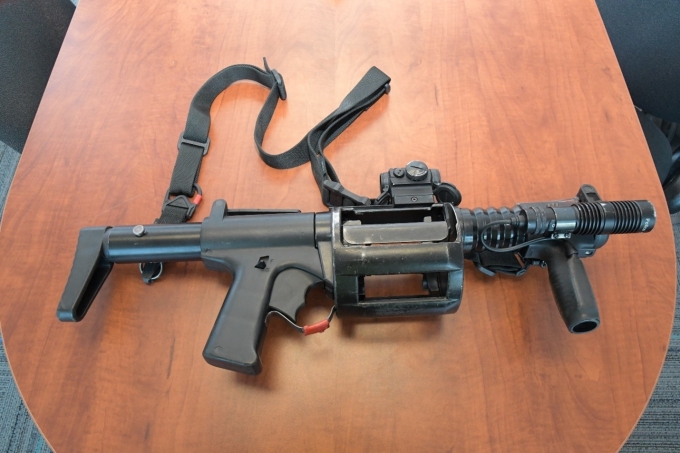
Figure 1 – ARWEN
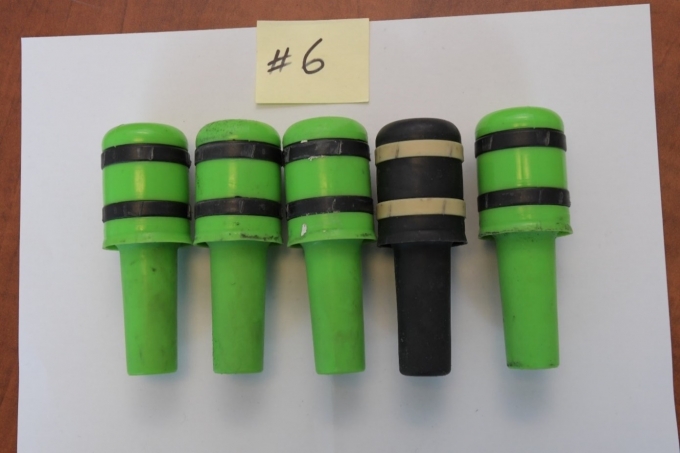
Figure 2 - Five ARWEN rounds
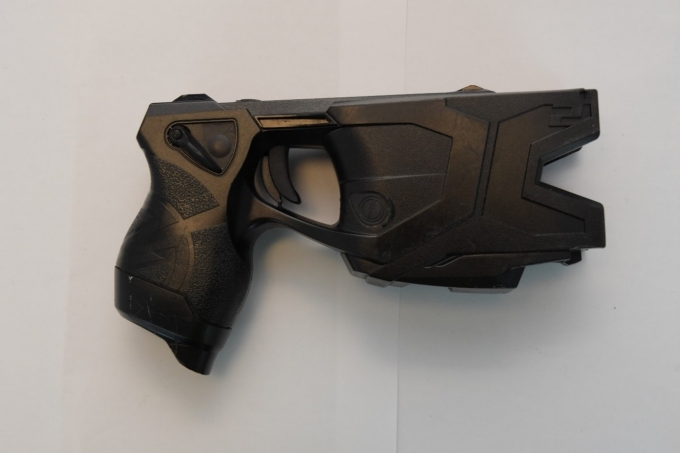
Figure 3 – WO #2’s CEW
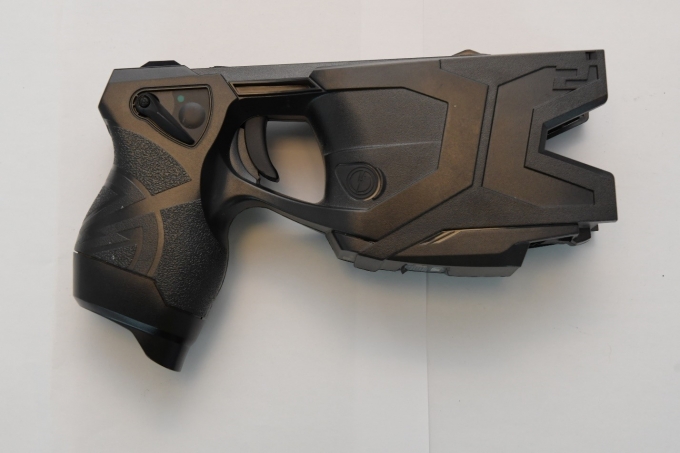
Figure 4 – WO #3’s CEW
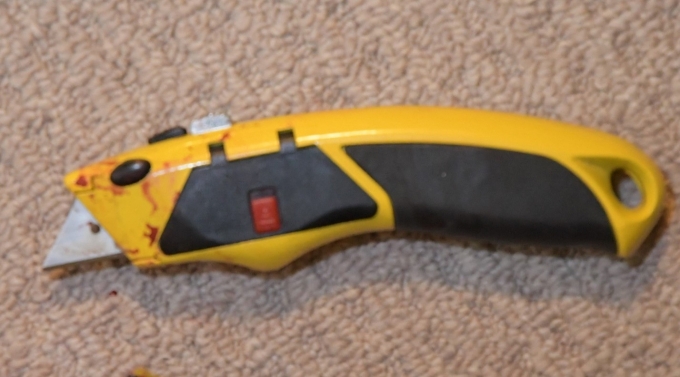
Figure 5 – The box cutter

Figure 6 – The knife or pruning saw
Forensic Evidence
CEW Data
At 5:29:54 p.m., [3] the CEW assigned to WO #3 recorded trigger depression activity. Cartridge one was deployed, and energy was sent to the probes. At 5:30:02 p.m., a second trigger activity was recorded that caused cartridge two to deploy. Energy was sent to the probes. Nine seconds later, a third trigger depression was recorded. At 5:30:31 p.m., the weapon’s safety was engaged, and the weapon turned off.The CEW assigned to WO #2 recorded activity starting at 5:31:13 p.m., when the safety was disengaged, and the weapon was turned on. Cartridges one and two were ready to be deployed. Immediately after being armed, the CEW’s trigger was depressed and cartridge one was deployed; energy was sent to its probes. Cartridge two remained ready for deployment. At 5:31:17 p.m., the weapon was made safe, and the weapon was turned off; cartridge one having been deployed, cartridge two ready for deployment.
Video/Audio/Photographic Evidence [4]
Non-Emergency Calls to HRPS
The Complainant’s psychotherapist called HRPS several times on November 17, 2021, regarding her patient, the Complainant. The following is a summary of those calls.At 3:54:38 p.m., the therapist called and identified herself, saying the Complainant was not doing well and talking about “ending it”. She told the call-taker she had made a call to HRPS this past summer, regarding the same patient, and the police had found him at Lake Ontario. The therapist did not have access to her files and was not able to provide the Complainant’s address. On this occasion, she did not know how seriously to take the Complainant’s threats, but he had told her he was “done” and hung up on her. She described the Complainant as military trained.
The call-taker asked the therapist if the Complainant said how he intended to harm himself, and she replied in the negative. He did tell her via text message that he had a Kevlar vest, and talked about being “done” and ending it once and for all. He also sent her photographs of his hands he had injured by hitting things. They were swollen and his fingers looked broken.
The call-taker asked the therapist if the Complainant had weapons. She responded that she had no idea. She said he was close to the edge. Having said that, she told the call-taker that the Complainant was calling her and, at 3:59 p.m., they ended their call so she could take the Complainant’s call.
At 4:00:57 p.m., the therapist made a second call to HRPS and spoke with a second call-taker. She said she was calling back to update the police that the Complainant was threatening to kill himself if police drove by his house because his wife was home. She then reported the receipt of a text message from the Complainant saying he had left his home because she told him police were coming. The call-taker asked if he told her where he was going, and she said, “He’s too smart for that.” She was not sure, when asked, if he had a car.
The therapist related her concern that if the police went to the Complainant’s door, and he was not home, he would never return and, “He would do it.” The call-taker told the therapist she understood and recorded her concerns, but the police legally had to investigate the Complainant’s well-being and were sending police officers to the home even though he may not be there. They would also check the area and do their best to locate him and make sure he was taken care of.
The therapist described the colour of the Complainant’s car and believed that, if it was not in the laneway by his house, he was not home.
The dispatcher assured the therapist the police were going to investigate and encouraged her to call back if she had any further information. The therapist said she was going to call the Complainant and try to talk him down from her end. She did not know what he wanted from her as he knew she had a legal duty to report his threats of self-harm. The call-taker told the therapist people in crisis who reached out was a good sign.
At 4:18:24 p.m., the therapist made a third call and told a third call-taker she had been speaking to the Complainant on the telephone and he sounded like he had given up. He told her, “I can’t do this. I’m doing this permanently,” then hung up and no longer responded to telephone calls or text messages. She did not know where he was, but he had told her he had five broken fingers from smashing his fists through walls and sent her pictures. She was concerned that if he reached out for her over the next few hours, she was not going to be able to answer his call as she had other patients to deal with. The call-taker told her police officers were on their way to the Complainant’s house and were almost there. The therapist told the call-taker she had just received a text message from the Complainant saying he hung up on the police, then said she believed a police officer was calling her. At 4:21:24 p.m., the call-taker let her go to answer that call.
At 4:46:43 p.m., the therapist placed a fourth call to HRPS and told that call-taker the Complainant had threatened to cut his hand off with a chainsaw and she was sure he had a chainsaw. She told the call-taker he had threatened to kill himself between now and Christmas Day, and that she had been on the telephone with him for 15 minutes and he had just hung up on her.
The call-taker asked if the Complainant mentioned the police and asked if he was home. The therapist did not know where he was. The call-taker asked if he mentioned seeing the police or being triggered by the sight of them. The therapist said the Complainant told her police vehicles were outside his house, he was miles away, but his son really liked seeing them there. She also told the call-taker she had been talking to another officer before this last call with the Complainant. The call-taker told her the call was updated and the therapist should call back with any updates. The call end at 4:50:21 p.m.
At 4:53:39 p.m., the therapist made a fifth call to HRPS and read a text message she had received from the Complainant. The message said, “Do the police want to see my wife and son in person now? Thanks a bunch. That’s nailed it for good.” The call-taker updated the call and told the therapist it appeared as if police officers were on the scene trying to deal with the situation. She told the therapist to continue calling with updates, and ended the call at 4:54:59 p.m.
At 4:59:54 p.m., the therapist placed a sixth call to HRPS and said she had been on the telephone with the Complainant, who was watching the police activity from somewhere close by his home. He told her he counted nine police officers at his home and was “really pissed off” because his son was now involved, and he was worried about the neighbours seeing what was going on. He wanted to cut his throat. He had nowhere to go. The call-taker confirmed there were a lot of police officers on the scene, and that they had visual contact with the Complainant and were trying to deal with the situation as best they could. That call ended at 5:02:14 p.m.
At 5:09:01 p.m., the therapist made a seventh call to HRPS to tell them she had just spoken with the Complainant, who told her the police officers had his family in a police vehicle. He had a knife and was going to cut his throat. He did not want to go to the hospital because he was abused in hospitals and feared it would happen again. The therapist told the call-taker the Complainant was irate, viewed the situation as a stand-off with police, and did not do well with ultimatums. That call ended at 5:11:06 p.m.
At 5:24:42 p.m., the therapist made an eighth call to HRPS and reported that the Complainant had just told her he had a knife at his neck. She told him to take it away because she wanted him to live. He mumbled something, then said, “I’m done,” and hung up. The call-taker told her he added her update to the call before, at 5:25:32 p.m., the therapist said she would call back with further updates and ended the call.
At 8:35:58 p.m., the therapist called HRPS for a ninth time and told the call-taker a police officer was supposed to have called her. She wanted to know if the Complainant was at the hospital. The call-taker said she would get someone to call her. That call ended at 8:36:48 p.m.
HRPS Communication Recordings
Officers were dispatched to respond to an attempted suicide at a residence on Millcroft Park Drive, Burlington. The dispatcher said the complainant was a psychotherapist and her patient, the Complainant, was saying he wanted to “end it”. Several police officers responded to the call including the Tactical Response Unit (TRU), and a Canine Unit, who staged near the residence. At 04:57 minutes into the recording, a police officer told the dispatcher he had a telephone conversation with the Complainant, who refused to disclose his location. At 09:50, Officer #1, the dog handler, broadcasted that he and another police officer had the rear of the residence contained and visual contact with the Complainant, who was on the second floor of the house.
At 13:36, WO #2 broadcasted the mission: to safely apprehend the Complainant at his home under Section 17 of the Mental Health Act. At 14:33, he broadcasted he had breeching tools, an ARWEN, and a shield ready.
At 15:32, the dispatcher broadcasted that the therapist had been on the telephone with the Complainant, who told her he had a knife to his neck, said he was done, and hung up.
At 15:55, a broadcast was made that the police may need to make entry to preserve life. Thirteen seconds later, a broadcast was made that entry was being made.
At 16:21, WO #2 broadcasted that the Complainant was in the basement with a knife to his neck.
At 16:26, a police officer broadcasted the need for Tactical Emergency Medical Services (TEMS) paramedics. Seven seconds later, Officer #1 reiterated they needed TEMS now.
At 16:38, a police officer broadcasted that the Complainant was in custody, had several lacerations to his throat, and was conscious and breathing. He asked for a time estimate on the arrival of TEMS.
At 17:01, information was broadcasted that the Complainant had an approximate 9-centimetre cut on his throat, pressure and bandages had been applied, and some of the Complainant’s clothing had been removed in anticipation of the arrival of paramedics.
At 17:30, a broadcast was made indicating paramedics were attending to the Complainant and police officers were clearing the rest of the home.
At 19:49, information was broadcasted that the Complainant was in an ambulance with a police officer headed for hospital.
At 21:53, information was provided that the Complainant’s injuries consisted of stab wounds to his neck and ARWEN hits to his right leg.
At 22:09, the ambulance arrived at the hospital with the Complainant conscious, breathing, and speaking with paramedics.
At 22:55, WO #2 made a broadcast asking if the police officer at the hospital with the Complainant knew how many CEW probes the Complainant had in him. The officer was told his transmitted question was indecipherable on the police radio at the hospital, and the police officer at the hospital asked WO #2 to call them. At 24:19, WO #2 broadcasted all CEW probes had been located.
Materials Obtained from Police Service
Upon request, the SIU received the following materials from HRPS between November 20, 2021 and December 16, 2021:- CEW Data Download Report – WO #3;
- CEW Data Download Report – WO #2;
- Event Chronology;
- Notes – SO #2;
- Notes – SO #1;
- Notes – WO #3;
- Notes – WO #1;
- Notes – WO #2;
- Notes – WO #4;
- Notes – WO #5;
- Occurrence Report;
- Persons in Crisis Form;
- Policy Directive-Use of Force;
- Policy Directive-Arrest and Release of Persons;
- Policy Directive-Police Response to Persons in Crisis;
- Policy Directive-Hostage Taking and Barricaded Persons;
- Scenes of Crime Officer Report;
- Communication recordings;
- Use of Force Report-CEW – WO #3;
- Use of Force Report-CEW – WO #2; and
- Use of Force Report - TRU Team.
Materials Obtained from Other Sources
The SIU obtained and reviewed the following records from other sources: - Medical Records – HGH.
Incident Narrative
The material events in question are clear on the evidence collected by the SIU, and may briefly be summarized. As was their legal right, neither subject official agreed to interviews with the SIU. They did authorize the release of their notes.
In the late afternoon of November 17, 2021, HRPS officers began to deploy at the residence of the Complainant on Millcroft Park Drive. They were there following multiple 911 calls from the Complainant’s therapist conveying her concerns that the Complainant was on the precipice of harming himself. In several communiqués with the therapist that day, the Complainant had suggested as much.
SO #1 and SO #2 were among a group of officers who convened at the residence – a two-story detached home. In light of the information provided by the therapist, it was decided that the Complainant would be apprehended under the Mental Health Act.
At about 5:30 p.m., following a period of attempted negotiations with the Complainant, a team of officers was authorized to enter the residence. The team, including SO #2, armed with an ARWEN, entered through the front door and set about trying to find the Complainant. They came to learn that the Complainant was in the basement – the therapist, still on the phone with a 911 operator, had advised the police that the Complainant could hear the officers above him.
The Complainant retreated to the basement’s recreation room at the sight of the officers arriving in the basement. He closed the glass-paned door to the room behind him, after which he smashed out one of the panes with a pruning saw he held in a hand. He held a box cutter in his other hand.
Led by WO #2, armed with a C8 rifle, officers entered the recreation room and confronted the Complainant. The Complainant had the box cutter to his neck and was in the process of cutting himself when SO #2, who had entered the room behind WO #2, fired all five rounds from his ARWEN at the Complainant. The Complainant reacted by lowering the knife from his throat, after which he was subjected to several CEW discharges that caused him to fall to the floor.
Following a period of struggle on the floor, in which the Complainant was again subjected to a CEW discharge and dispossessed of the box cutter, the officers were able to handcuff his arms behind his back. Thereafter, they applied first aid to the lacerations the Complainant had inflicted on his neck.
Paramedics attended the scene, took charge of the Complainant’s care, and transported him to hospital. He was diagnosed and treated for two lacerations to his neck, and admitted for psychiatric examination. He had also sustained areas of bruising consistent with ARWEN impacts.
In the late afternoon of November 17, 2021, HRPS officers began to deploy at the residence of the Complainant on Millcroft Park Drive. They were there following multiple 911 calls from the Complainant’s therapist conveying her concerns that the Complainant was on the precipice of harming himself. In several communiqués with the therapist that day, the Complainant had suggested as much.
SO #1 and SO #2 were among a group of officers who convened at the residence – a two-story detached home. In light of the information provided by the therapist, it was decided that the Complainant would be apprehended under the Mental Health Act.
At about 5:30 p.m., following a period of attempted negotiations with the Complainant, a team of officers was authorized to enter the residence. The team, including SO #2, armed with an ARWEN, entered through the front door and set about trying to find the Complainant. They came to learn that the Complainant was in the basement – the therapist, still on the phone with a 911 operator, had advised the police that the Complainant could hear the officers above him.
The Complainant retreated to the basement’s recreation room at the sight of the officers arriving in the basement. He closed the glass-paned door to the room behind him, after which he smashed out one of the panes with a pruning saw he held in a hand. He held a box cutter in his other hand.
Led by WO #2, armed with a C8 rifle, officers entered the recreation room and confronted the Complainant. The Complainant had the box cutter to his neck and was in the process of cutting himself when SO #2, who had entered the room behind WO #2, fired all five rounds from his ARWEN at the Complainant. The Complainant reacted by lowering the knife from his throat, after which he was subjected to several CEW discharges that caused him to fall to the floor.
Following a period of struggle on the floor, in which the Complainant was again subjected to a CEW discharge and dispossessed of the box cutter, the officers were able to handcuff his arms behind his back. Thereafter, they applied first aid to the lacerations the Complainant had inflicted on his neck.
Paramedics attended the scene, took charge of the Complainant’s care, and transported him to hospital. He was diagnosed and treated for two lacerations to his neck, and admitted for psychiatric examination. He had also sustained areas of bruising consistent with ARWEN impacts.
Relevant Legislation
Section 25(1), Criminal Code -- Protection of persons acting under authority
25 (1) Every one who is required or authorized by law to do anything in the administration or enforcement of the law
(a) as a private person,(b) as a peace officer or public officer,(c) in aid of a peace officer or public officer, or(d) by virtue of his office,
is, if he acts on reasonable grounds, justified in doing what he is required or authorized to do and in using as much force as is necessary for that purpose.
Analysis and Director's Decision
On November 17, 2021, the Complainant suffered a serious injury inside his home in Burlington. As HRPS officers were in and around the property at the time, the SIU was notified and initiated an investigation. SO #1 and SO #2 were identified as subject officials. The investigation is now concluded. On my assessment of the evidence, there are no reasonable grounds to believe that either subject official committed a criminal offence in connection with the Complainant’s injuries.
Pursuant to section 25(1) of the Criminal Code, police officers are immune from criminal liability for force used in the course of their duties provided such force was reasonably necessary in the execution of an act that they were authorized or required to do by law.
Given what they knew of the Complainant’s mental distress and suicidal ideation via his therapist, I am satisfied that the Complainant was subject to lawful apprehension under section 17 of the Mental Health Act.
I am further satisfied that the force used in aid of the Complainant’s arrest, namely, multiple ARWEN and CEW discharges, were legally justified. The Complainant was in mental crisis and of unsound mind at the time. He had armed himself with two edged-weapons intending to do himself harm, and had embarked on that course as police confronted him in the basement of his home. Time was clearly of the essence if the officers were going to prevent serious harm or death coming to the Complainant. In the circumstances, I am unable to reasonably conclude that the discharge of five less-lethal rounds from the ARWEN and CEW deployments were excessive as they stood to immediately incapacitate the Complainant without inflicting grievous bodily injury. In fact, that is what occurred. The Complainant’s hand with the box cutter in it was promptly drawn away from his neck. And the CEW discharges were successful in bringing the Complainant to ground, where his position of relative disadvantage meant the officers could move in to safely take him into custody. Given his resistance on the ground, it would appear that a further CEW discharge, this time applied in drive stun mode, was also reasonable given the imperative to quickly subdue the Complainant and render medical care to his serious wounds.
As for the officers’ conduct in and around the home preceding the Complainant’s arrest, and their decision to enter the residence when they did, there is no evidence to suggest that the subject officials, or any of the involved officers, failed to comport themselves with due care and regard for the Complainant’s health and well-being. Having received reports from the Complainant’s therapist expressing concern for his safety, the police were duty bound to respond to the address to do what they reasonably could to prevent harm coming to the Complainant. Once on scene, they attempted unsuccessfully to negotiate a peaceful resolution to the stand-off, and only entered upon reasonably concluding, based on what they were being told by the therapist, communicating with the Complainant at the time, that the Complainant was on the brink of self-harming. On this record, I am satisfied that the police interventions likely had more to do with saving the Complainant’s life than they had to do with the serious neck injuries he inflicted on himself.
In the result, as there are no reasonable grounds to believe that the subject officials conducted themselves unlawfully throughout their engagement with the Complainant, there is no basis for proceeding with criminal charges in this case.
Date: March 9, 2022
Electronically approved by
Joseph Martino
Director
Special Investigations Unit
Pursuant to section 25(1) of the Criminal Code, police officers are immune from criminal liability for force used in the course of their duties provided such force was reasonably necessary in the execution of an act that they were authorized or required to do by law.
Given what they knew of the Complainant’s mental distress and suicidal ideation via his therapist, I am satisfied that the Complainant was subject to lawful apprehension under section 17 of the Mental Health Act.
I am further satisfied that the force used in aid of the Complainant’s arrest, namely, multiple ARWEN and CEW discharges, were legally justified. The Complainant was in mental crisis and of unsound mind at the time. He had armed himself with two edged-weapons intending to do himself harm, and had embarked on that course as police confronted him in the basement of his home. Time was clearly of the essence if the officers were going to prevent serious harm or death coming to the Complainant. In the circumstances, I am unable to reasonably conclude that the discharge of five less-lethal rounds from the ARWEN and CEW deployments were excessive as they stood to immediately incapacitate the Complainant without inflicting grievous bodily injury. In fact, that is what occurred. The Complainant’s hand with the box cutter in it was promptly drawn away from his neck. And the CEW discharges were successful in bringing the Complainant to ground, where his position of relative disadvantage meant the officers could move in to safely take him into custody. Given his resistance on the ground, it would appear that a further CEW discharge, this time applied in drive stun mode, was also reasonable given the imperative to quickly subdue the Complainant and render medical care to his serious wounds.
As for the officers’ conduct in and around the home preceding the Complainant’s arrest, and their decision to enter the residence when they did, there is no evidence to suggest that the subject officials, or any of the involved officers, failed to comport themselves with due care and regard for the Complainant’s health and well-being. Having received reports from the Complainant’s therapist expressing concern for his safety, the police were duty bound to respond to the address to do what they reasonably could to prevent harm coming to the Complainant. Once on scene, they attempted unsuccessfully to negotiate a peaceful resolution to the stand-off, and only entered upon reasonably concluding, based on what they were being told by the therapist, communicating with the Complainant at the time, that the Complainant was on the brink of self-harming. On this record, I am satisfied that the police interventions likely had more to do with saving the Complainant’s life than they had to do with the serious neck injuries he inflicted on himself.
In the result, as there are no reasonable grounds to believe that the subject officials conducted themselves unlawfully throughout their engagement with the Complainant, there is no basis for proceeding with criminal charges in this case.
Date: March 9, 2022
Electronically approved by
Joseph Martino
Director
Special Investigations Unit
Endnotes
- 1) Issued to and used by WO #3. [Back to text]
- 2) Issued to and used by WO #2. [Back to text]
- 3) Times are derived from the weapons’ internal clocks, which are not necessarily synchronous between weapons or actual time. [Back to text]
- 4) The following records contain sensitive personal information and are not being released pursuant to section 34(2) of the Special Investigations Unit Act, 2019. The material portions of the records are summarized below. [Back to text]
Note:
The signed English original report is authoritative, and any discrepancy between that report and the French and English online versions should be resolved in favour of the original English report.
